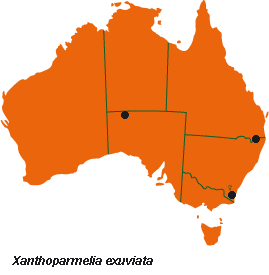



Australian Biological Resources Study
| Checklist of the Lichens of Australia and its Island Territories | ||
| Introduction | A–D | E–O | P–R | S–Z | Oceanic Islands | References | ||
| Xanthoparmelia exuviata (Kurok.) Hale | ||
| Mycotaxon 20: 79 (1984); Parmelia exuviata Kurok., Bull. Natl Sci. Mus., ser. B, 8: 36 (1982). T: east of Cooma on the Numeralla Road, N.S.W., 2 Dec. 1965, S.Kurokawa 6449; holo: TNS; iso: CANB. | ||
| Thallus foliose, loosely adnate, to 4–9 cm wide. Lobes imbricate or not, short, flat, sublinear, irregularly branched, 1.5–3 mm wide. Upper surface yellow-green, dull, emaculate, without soredia; older lobes becoming rugulose, cracked and ± areolate; upper cortex fragile, occasionally flaking off in places; isidia numerous, simple, warty or sparingly branched, cylindrical and ±inflated at apices; isidia apices epicorticate and only rarely erumpent, not sorediose. Medulla white. Lower surface pale brown to brown; rhizines sparse, 0.1–0.2 mm long, concolorous. Apothecia sessile, 2–3 mm wide; disc concave, brown to dark brown; thalline exciple isidiate. No mature ascospores seen. Pycnidia common. Conidia bifusiform, 6–7 × 0.5 µm. CHEMISTRY: cortex K-, UV-; medulla K-, C-, KC-, P-; containing usnic acid, exuviatic acid A and exuviatic acid B. |  |
|
| Rare, endemic, in upland regions, in arid or subarid areas or areas of moderate rainfall in eastern and central Australia (S.A., Qld and N.S.W.); also on Lord Howe Is. Grows on rock. | ||
| Elix (1994z) | ||
| Checklist Index |
| Introduction | A–D | E–O | P–R | S–Z | Oceanic Islands | References |
This work is copyright. Apart from any use as permitted under the Copyright Act 1968, no part may be reproduced by any process without prior written permission from Australian Biological Resources Study. Requests and inquiries concerning reproduction and rights should be addressed in the first instance to Dr P. McCarthy. These pages may not be displayed on, or downloaded to, any other server without the express permission of ABRS.